“In preparing for battle, I have always found that strategies are useless, but strategizing is indispensable” might be a frank reformulation of the famous quote by Dwight D. Eisenhower[note] In preparing for battle I have always found that plans are useless, but planning is indispensable.[/note]. Still, the truth of the increasingly complex business environment is that plans and strategies are invalidated faster and faster. Few CEOs nowadays honestly think that their 5-year or even 3-year strategy is going to last.
Nevertheless, many CEOs nowadays have forgotten that “… strategy has two equally important aspects, interrelated in life … The first of these is formulation; the second implementation … in real life, the processes of formulation and implementation are intertwined. Feedback from operations gives notice of changing environmental factors to which the strategy should be adjusted. The formulation of strategy is not finished when implementation begins. A business organization is always changing in response to its own makeup and past development. Similarly, it should be changing in response to changes in the larger systems in which it moves and in response to its success or failure in affecting its environment.” Andrews 1971 [note] Kenneth R. Andrews : The Concept of Corporate Strategy. 1971 Dow Jones-Irwin Inc. Professor of Business Administration, Harvard University.[/note]
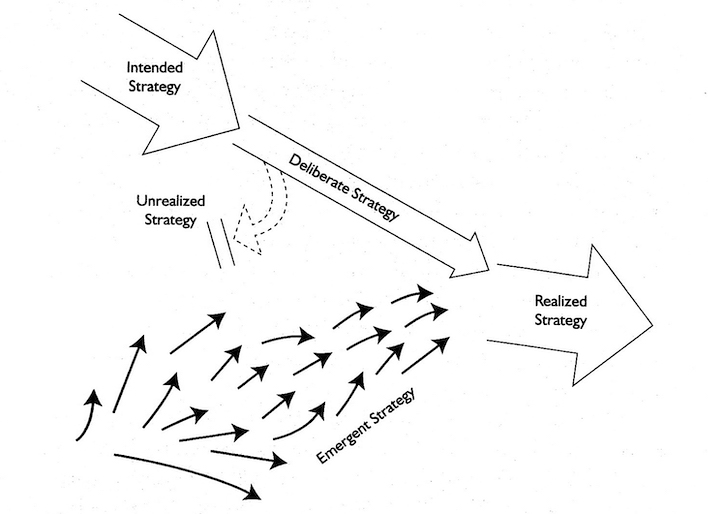
20 years later after Andrew’s book, i.e., 30 years ago, the management thinker Henry Mintzberg[note] Mintzberg, Henry, and James A. Waters. “Of Strategies, Deliberate and Emergent.” Readings in Strategic Management (1989).[/note] further discussed the difference between the intended strategy and the realized strategy created by responding to internal and external changes (see figure to the right). He argues that only a small proportion of the realized strategy is deliberate while the emergent part increases over time.
Every part of running an organization has become more complex over the last thirty years, which means that organizations must continuously strategize to transform changes to emergent strategy.
In its simplest form that means that the strategy-process changes from a perceived linear stage-gate process to a continuous iterative strategizing process as illustrated below:

The first consequence of thinking like this is that a strategy is never new – it is rather an improvement of what was already there. If you think about it: Was there ever a new strategy except when the founders of the company first met ‘in the garage’? Whatever followed that day was adjustments to an existing strategy, organization, products, adjusted customer focus, etc. No matter how radical a new strategy seems, it always contains a continuation of an existing business.
Another consequence of replacing long strategy-periods with continuous strategizing becomes clear as strategy iterations are getting shorter, i.e., the strategy is adjusted more often due to changes/feedback: The people who’re strategizing must be closer to daily business to shorten the feedback loop. The easiest way to get the feedback into the strategy loop is to involve people from the organization who are in the feedback loops with customers, namely those who are in continuous contact with them directly or through IT-systems.
The top-down multi-year-strategy-process was easy to understand, but it has become irrelevant.
The ambition of this article is to make it very concrete how strategies can become more like a living organism than a static document, and make it clearer how strategizing involving large parts of the organization continuously and rapidly can adapt the strategy relevantly. This should be an indispensable capability of every organization.
Strategies in larger organizations
Large organizations are in themselves quite complex, so to explain how even they can strategize despite the complexity, I’ll build up from something quite simple – the company with one product/value chain.
My background is Agile product development, and I’ve written a couple of articles[note]http://www.managecomplexity.dk/blog/2019/05/23/agile-planning-circles/ and http://www.managecomplexity.dk/blog/2019/05/24/agile-planning-circles-the-artifacts/[/note] about coupling your product vision/strategy to execution and involving large parts of the organization in strategizing. If you have deep interest, follow the links, but to understand the rest of this article, it is enough to understand a few things in the figure below.
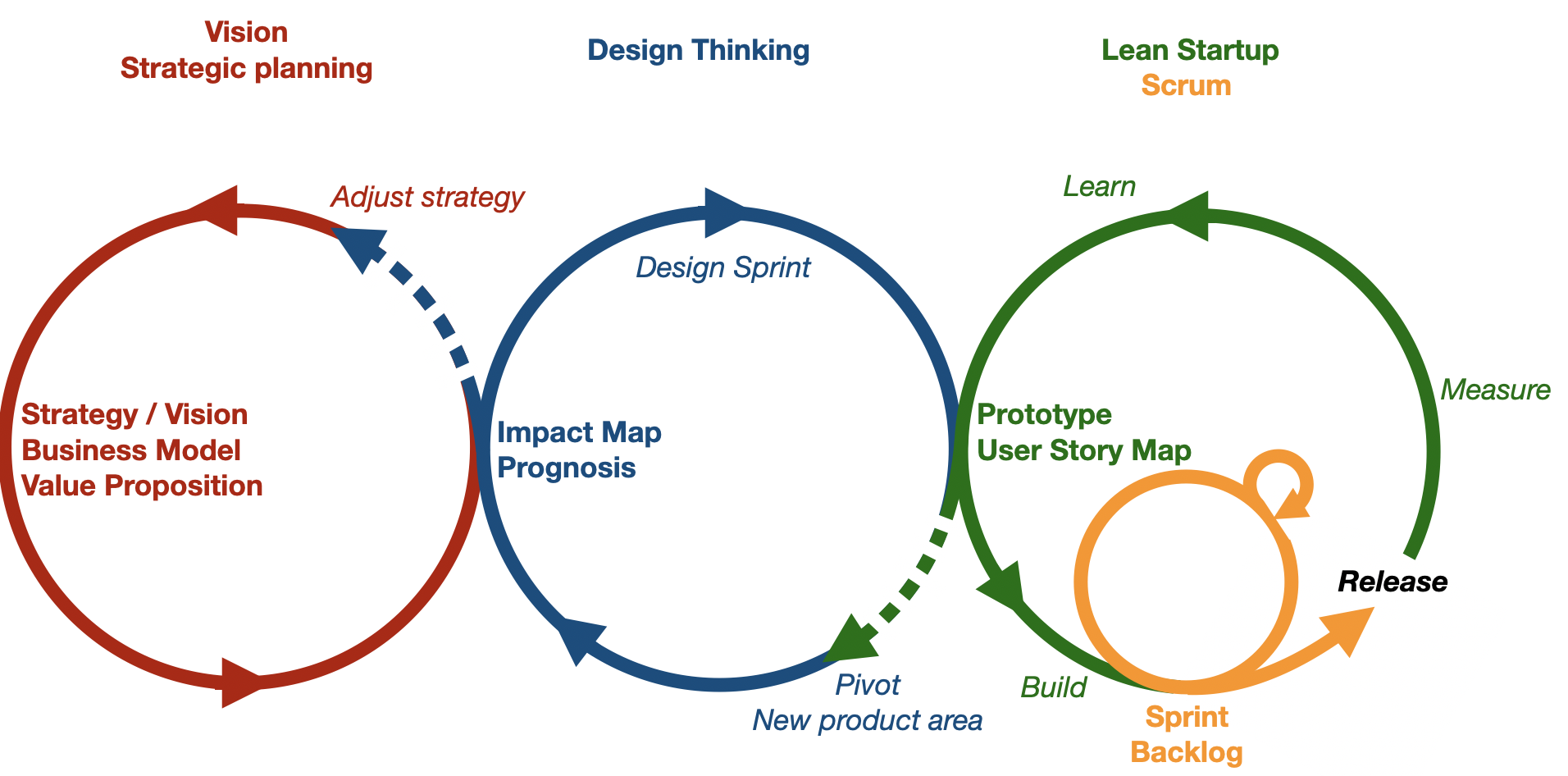
The red circle is the iterative strategy circle where vision/strategy and whatever artifacts you use for that, are maintained. The strategy circle gets feedback (dotted blue arrow) from the execution circles, i.e., the blue/green/orange circles. Later in the article, it’s good to understand that the blue circle is about testing strategy/product ideas with high-fidelity prototypes on customers before investing in development, i.e., the green circle. The execution circles are traversed in a few weeks/days continuously creating learning that might affect, maybe even invalidate the strategy, and a pivot is necessary. To understand this more in-depth, you should dive into Lean Startup by Eric Ries[note] https://www.amazon.com/Lean-Startup-Entrepreneurs-Continuous-Innovation/dp/0307887898 [/note].
Larger companies often have several products/value streams in several business areas, supported by several IT-platforms – and all should be aligned strategically. Examples could be a financial institution with banking, investments, mortgages, pension, insurance, etc. for both private and business customer, or a media company with TV, papers, radio for consumers and advertisers. For a financial institution, it could look like the figure below where the value streams to consumers (depicted as the grey arrow) and business customers encapsulate the business areas (colored boxes: mortgages, insurance, and banking to consumers; insurance, banking, and pension to business customers). Everything backed by different IT-platforms (black squares):
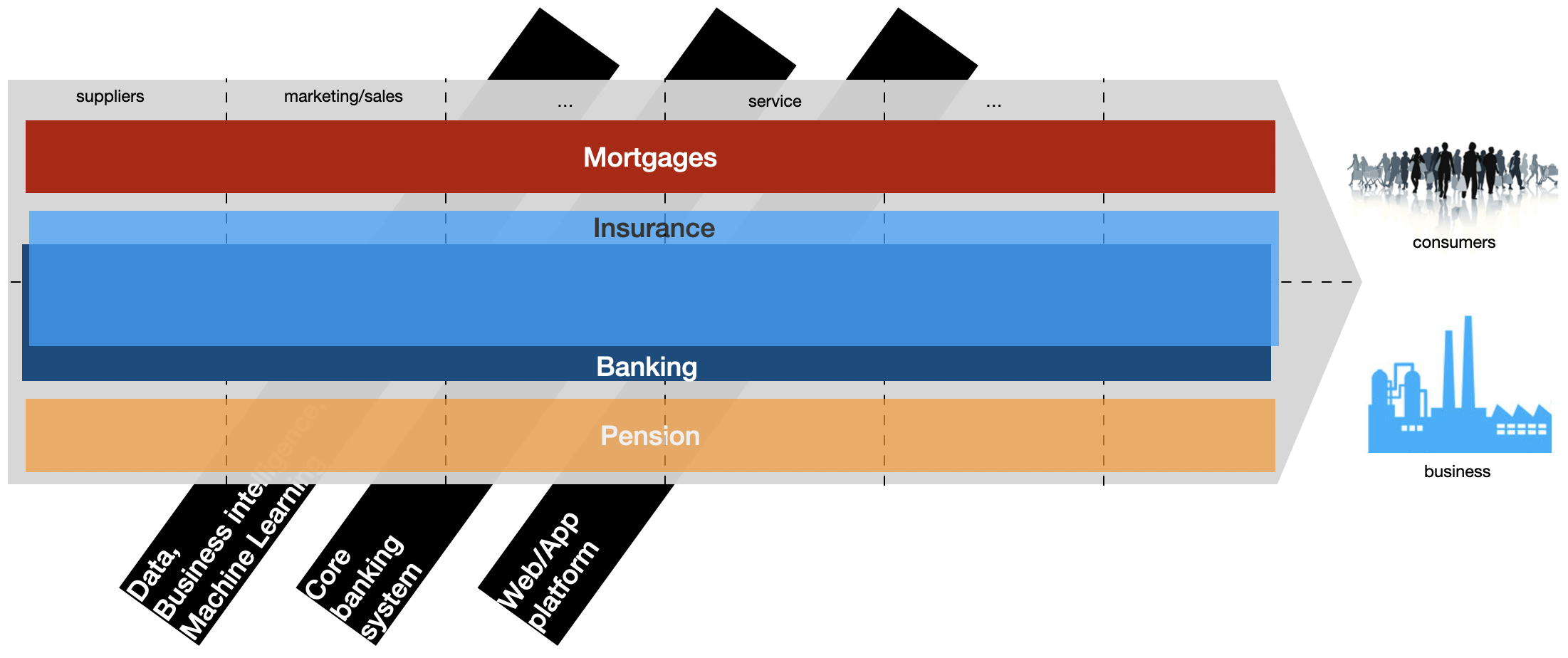
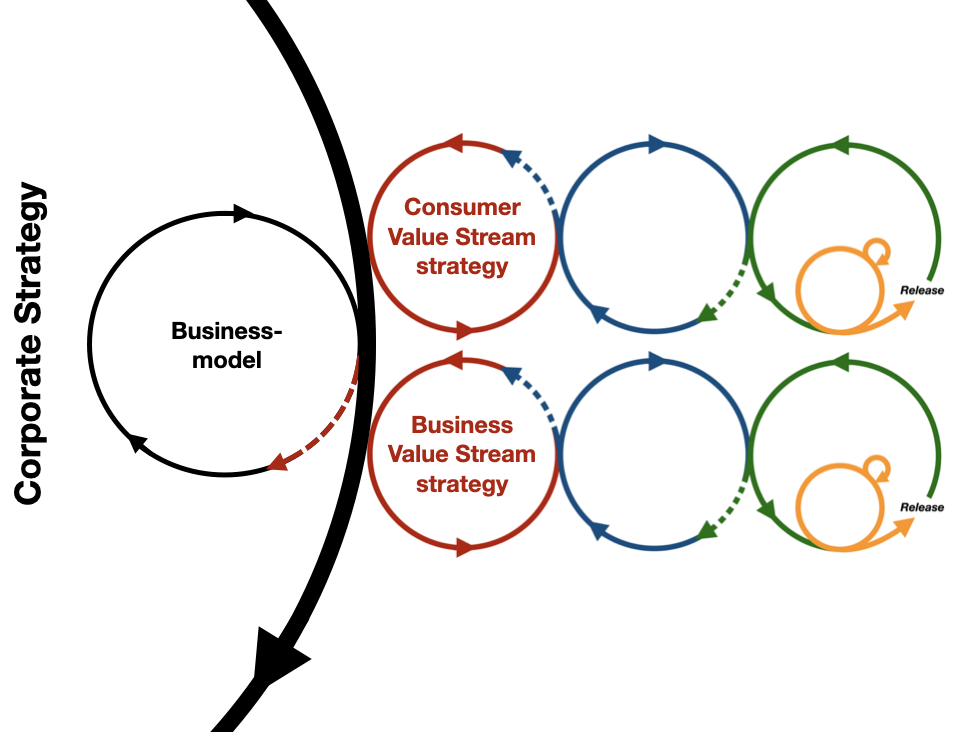
The financial institution, of course, has a corporate strategy (thick black circle, partly shown to the right) that contains the corporate business model (thin black strategic circle). The business model is the joint perspective on the value streams, and it is, of course, connected to the red strategic circles for the value streams; in this example directed towards consumers and business customers. In reality, the value streams can be more fine-grained, e.g., the consumer value stream split between self-service and advisory.
Regardless of how the business is run, strategizing in this example means that corporate strategy influences the corporate business model, which influences the strategies for each value stream. However, visa versa is also true: learnings in the execution circles influence the value stream strategy, which might change the business model and corporate strategy.
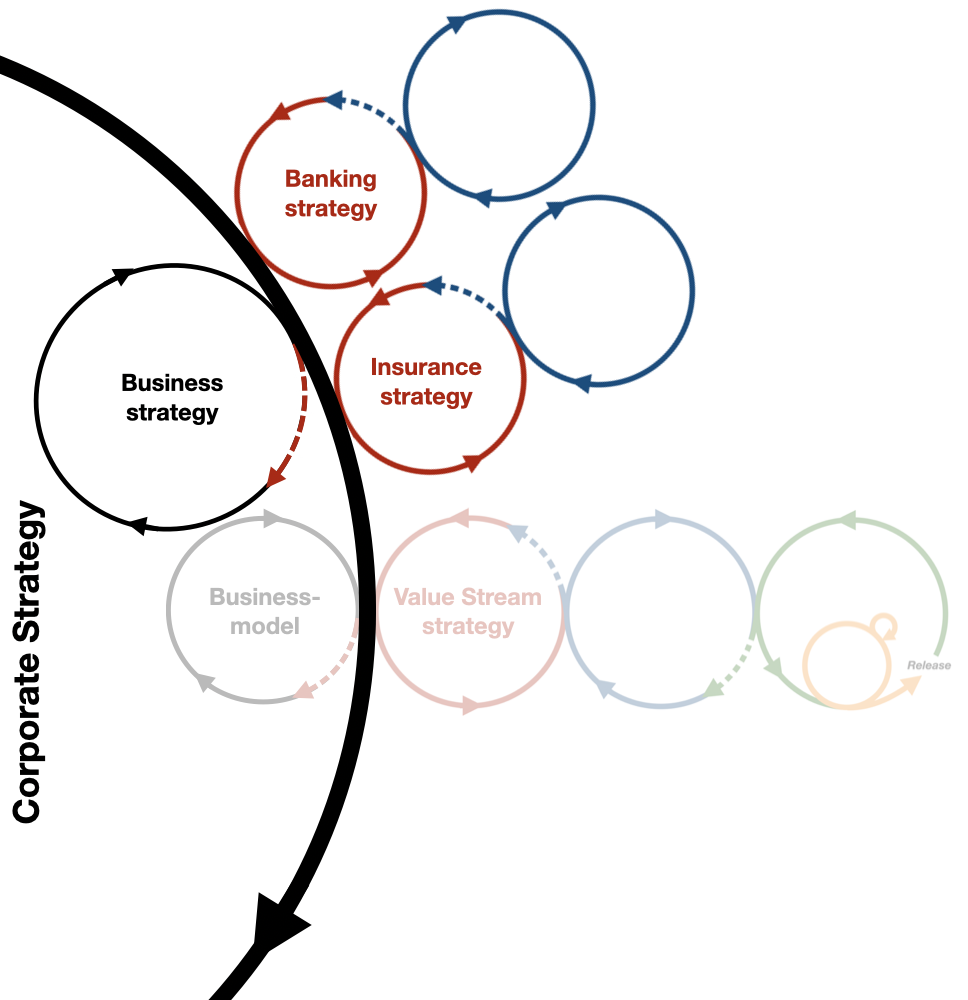
In the example, both consumers and business customers are offered banking, insurance services, etc. and this financial institution has to compete with competitors specializing in each business area. Therefore it has several business area strategies that ensure that the products in each business area are competitive. The business area strategies aggregate at the corporate level in a business strategy that ensures alignment between the different business areas. For example, that the insurance part of the banks Mastercard is aligned/supplements, e.g., the travel insurance.
Strategizing means that changes in strategy go both ways: left-to-right (corporate strategy -> business model -> business area) and right-to-left. In the figure, I left out the green circles in the business areas, because I believe that development should primarily be customer directed, i.e. ,happen within the scope of a value stream. This is, however, a discussion for another time. Of course, development can also happen in business areas.
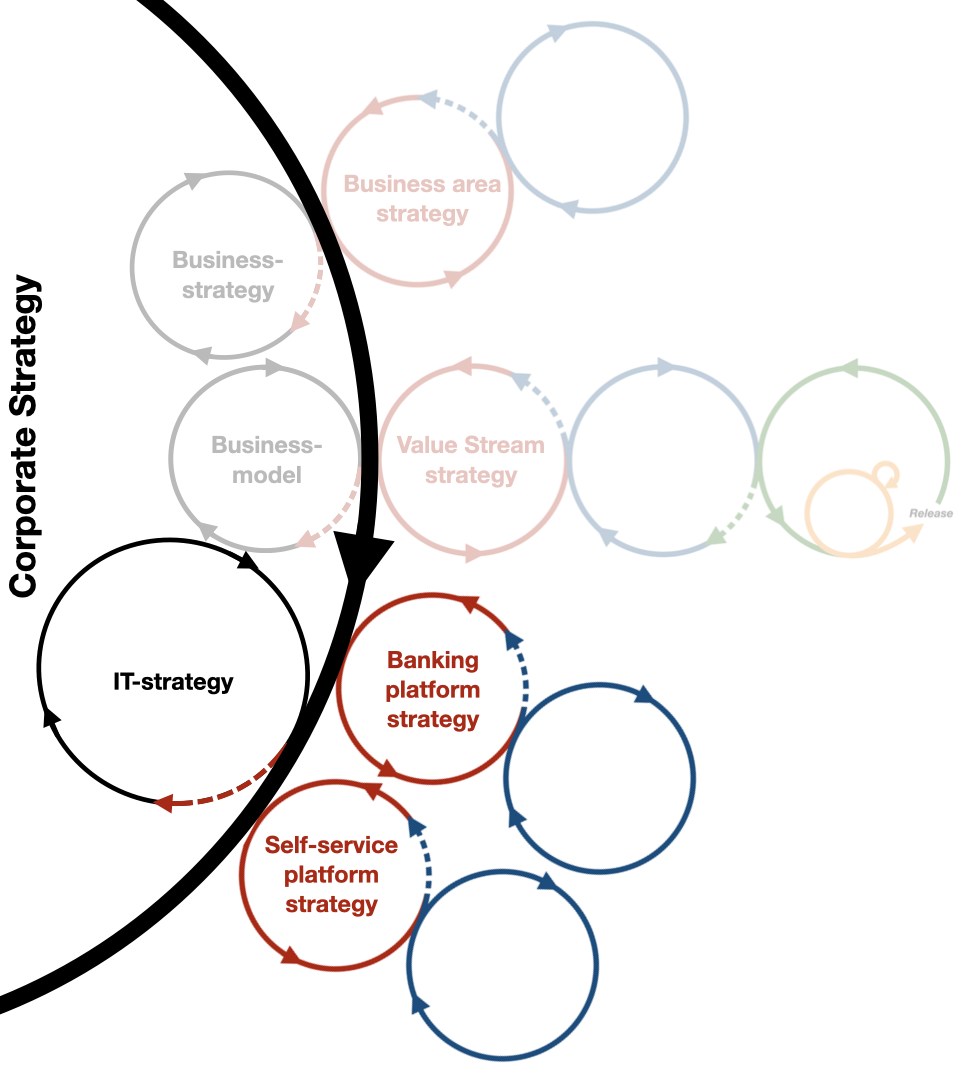
To fulfill the picture, we must also be strategic on our IT-platform. The IT-strategy is, of course, part of the corporate strategy, and it is extended by strategies for different parts of the IT-infrastructure, e.g., core banking systems, the platform for developing web-/app-solutions for customers, etc.
The benefit of having these distributed strategies is that people working on these platforms can be directly involved in strategizing. Their insight in the platforms surfaces new opportunities or insufficiencies faster, to the benefit of all other strategic circles. Being involved also ensures that they work in a strategic direction every day.
Across the different dimensions (business, value streams, IT) and different levels (corporate, sub-corporate, red strategies), the number of strategies adds up to a considerable number of strategies that need to be both aligned and up to date. You probably have many of these strategies in documents and presentations around your company – but neither aligned nor updated. That requires both coordination and transparency. How this is achievable, I’ll try to explain in the following paragraphs.
Strategizing across the organization
Every strategic circle has its rhythm for updates, and as it is connected to several other strategic circles, they are asynchronously triggered by changes in other circles as well. It is not nearly as complicated to orchestrate as it might sound. After a few examples, it is more evident. Just follow the arrows in the examples.
Ex #1: Corporate strategy changes
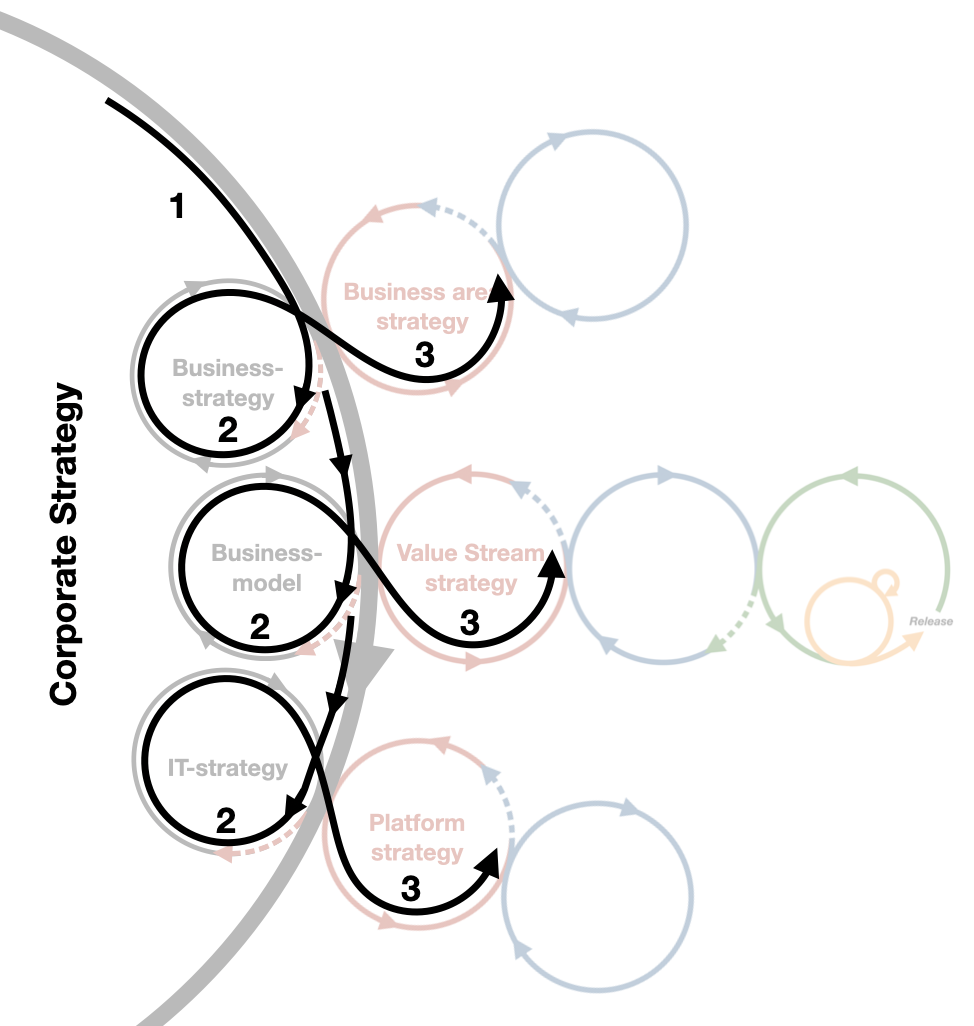
First, let’s look at the traditional top-down strategy process (see figure to the right). It starts at the C-level as, for example, a quarterly adjustment to the existing strategy (thick black circle – start at 1). The adjustment is discussed with the groups responsible for business strategy, business model, and IT-strategy (thin black circles – see 2), and the changes they make, cascade to more detailed strategies within each dimension (red circles – see 3) where execution starts. In the figure to the right, the parallel cascading is illustrated.
Ex #2: Strategic reaction in a business area
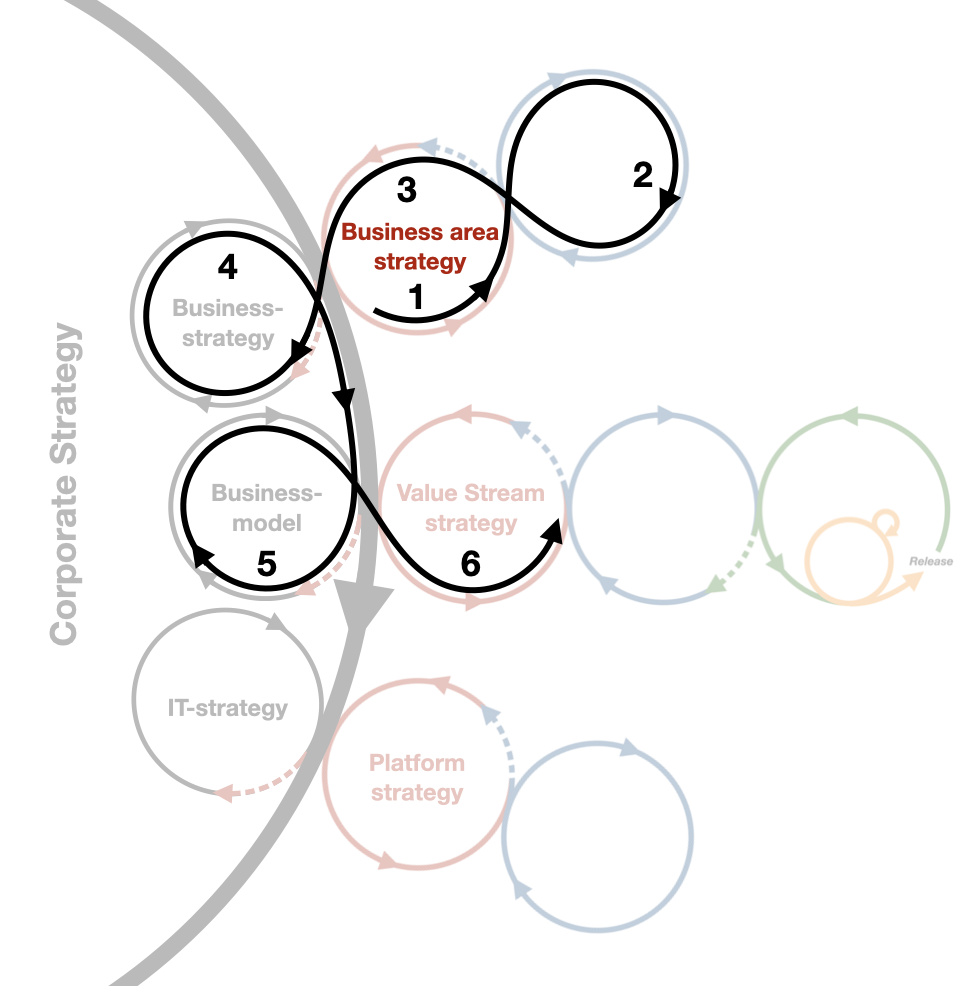
The strategy circle in a business area (red circle – start at 1) might have a fixed cadence like the corporate strategy, where competition is analyzed, and reactions are made accordingly. For this example, let’s say that the financial institution’s insurance-business-area finds that a competitor has gotten a competitive advantage by offering different payment options and terms, and they want to react.
First, they test their assumptions (at 2) regarding how they should react, and then build it into the business area strategy (at 3). Then it is run by the business strategy (at 4) to determine if new payment options/terms also should apply to other business areas (banking is probably relevant), and run by the business model (at 5) for change and then it is incorporated into the value stream strategies (at 6). In this case, it might only be relevant for the consumer value stream, and it is executed through that (see figure to the right).
Ex #3: Strategizing from outside the strategy circles
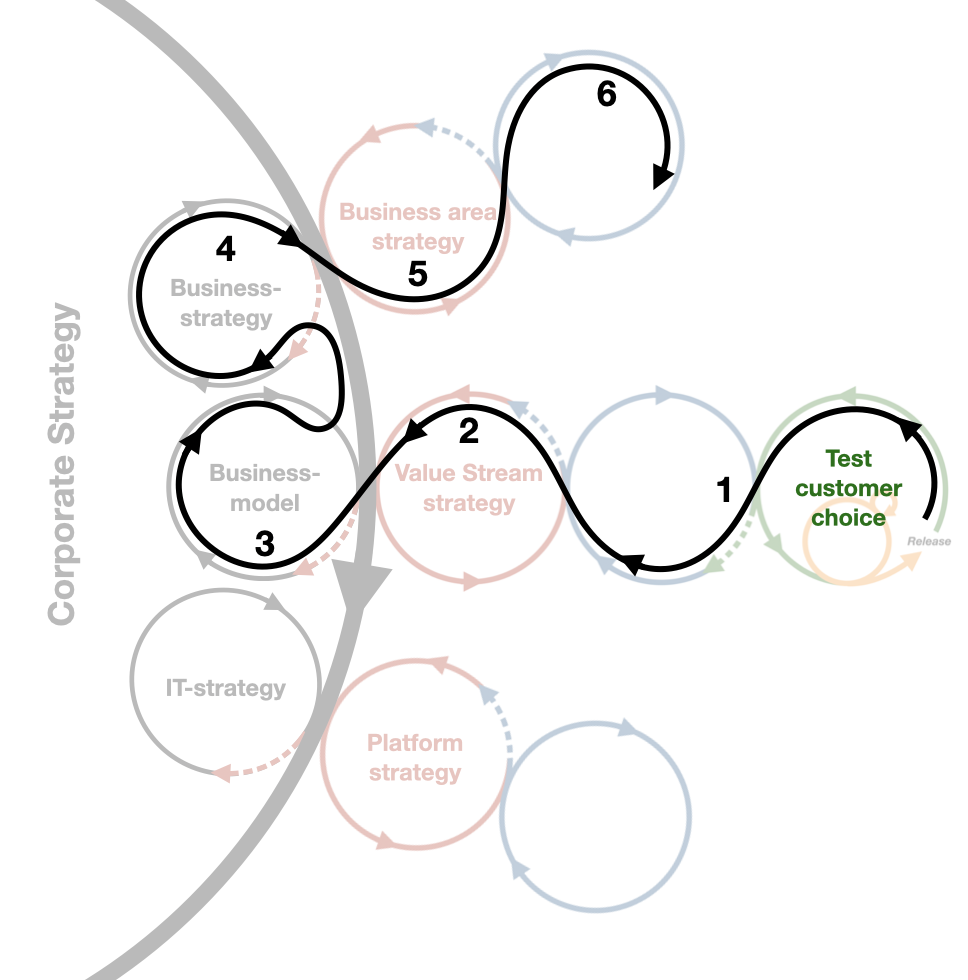
As discussed above, strategic changes in a dynamic environment are often initiated by the people close to the customers. As an example let’s take a team in the financial institution’s consumer value stream. As they were implementing functionality that allows customers to add to their standard insurance coverage, they were wondering if a year-long assumption in the company was valid. If customers were allowed to remove coverage, would it result in losses for the company? They set up an experiment where they tested the assumption and found that not only did the customers rarely remove coverages, and they were more likely to add coverage, knowing that they could easily remove it again.
The broken assumption was learning (start at 1) with considerable strategic significance. It resulted in changes in the value stream for consumers (2), it adjusted the business model (3) to emphasize the free choice for customers and circled on to the people around the business strategy (4). They realized that they had similar old assumptions about customer behavior in several business areas. One being that insurance business customers must be tied to very long contracts to be profitable. They decided to test (6) if they should change the business strategy (5) towards business customers as well.
These are just three examples of strategizing across levels and dimensions in the organization. You probably already think of other examples eg. IT-platforms to be replaced, new technological possibilities like Machine Learning, etc., which will create other paths through the strategy circles.
If you are explicit about all your different strategies, you can use this way of illustrating the navigation through strategy circles to design the processes for implementing desired strategy changes across the organization.
The above examples could easily happen simultaneously in one organization, because all the strategy circles have their cadence, and can still be interrupted by changes in other circles. To be able to keep strategies aligned and possible to execute an updated and transparent view on all strategies is needed. Let’s enter Obeya.
Obeya
Obeya (from Japanese 大部屋) means “big room,” and in Toyota, this room is used to speed up communication and decision making. Therefore it is an excellent place to strategize.
Imagine a room where corporate strategy, corporate sub-strategies, business-area strategies, etc. hang on the walls as updated, similar, easy-to-read artifacts, when you’re strategizing. My thoughts on the artifacts in Obeya will be the topic of another article that will occur here.
You’ll have the information you need and know whom to invite for a discussion to align directions, resolve issues, start collective initiatives, etc.
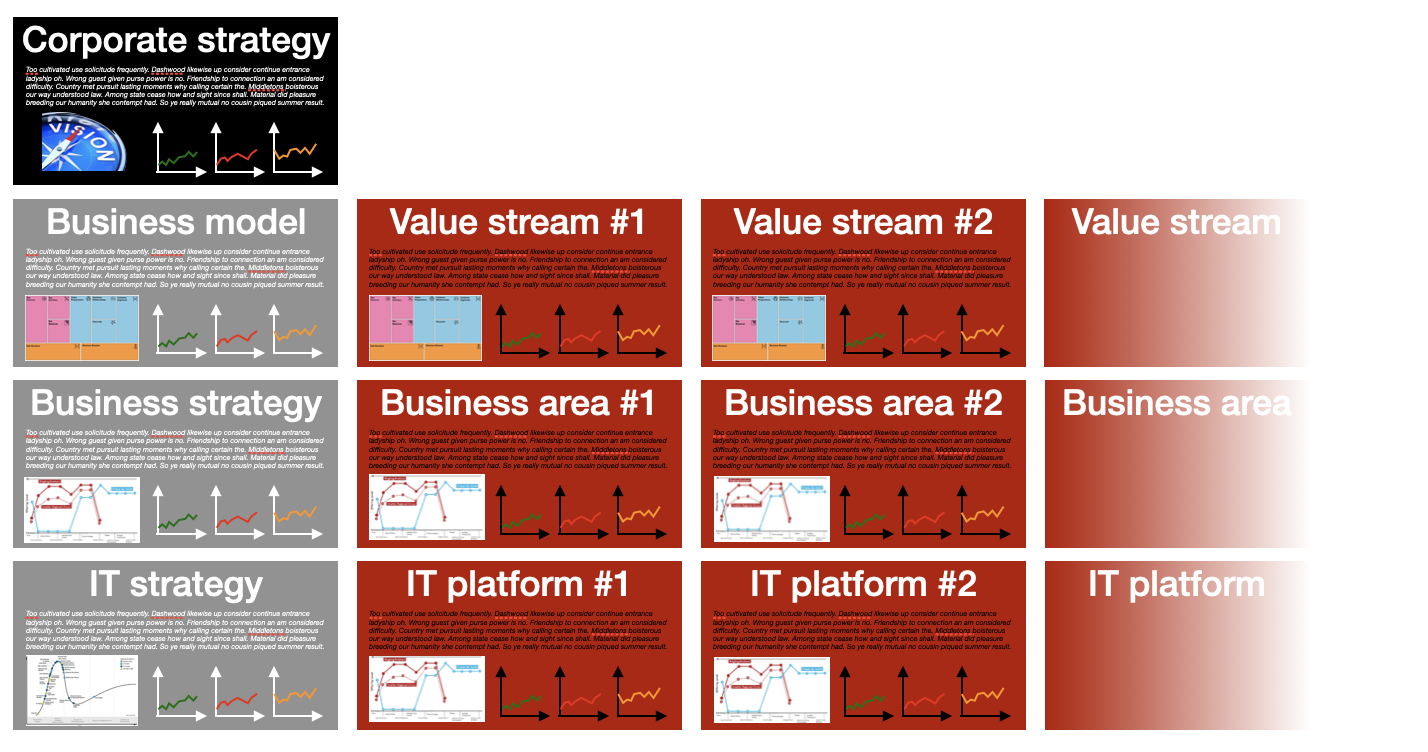
Obeya is always open for the whole organization, and relevant people find solutions rapidly together and update Obeya no matter if it is at fixed cadences of the different strategies or when learnings or external events happen, and there is a need to meet.
The organization as a whole is familiar with the strategies at all levels, and there are good chances are that they will work in the same direction – especially if the red strategy circles are tied as close to execution as described in the previously mentioned articles4.
A genuinely adaptive strategy known by the organization that executes it – indispensable when you go to battle.
.
